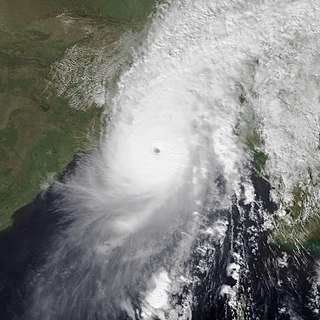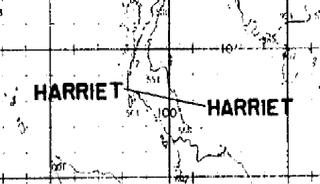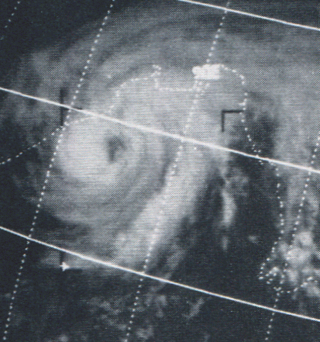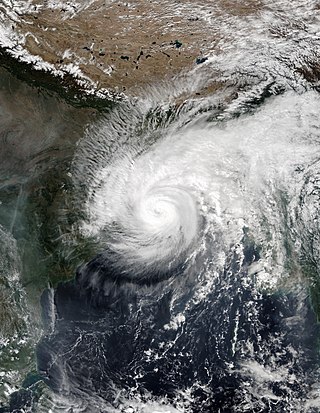
HMS Intrepid (L11) was one of two Fearless-class amphibious warfare ships of the Royal Navy. A landing platform dock (LPD), she served from 1967 until 1999. Based in HM Naval Base, Devonport, Plymouth, Devon and HM Naval Base Portsmouth, she saw service around the world over her 32-year life.

The 1991 Bangladesh cyclone was among the deadliest tropical cyclones on record. Forming out of a large area of convection over the Bay of Bengal on April 24, the tropical cyclone initially developed gradually while meandering over the southern Bay of Bengal. On April 28, the storm began to accelerate northeastwards under the influence of the southwesterlies, and rapidly intensified to super cyclonic storm strength near the coast of Bangladesh on April 29. After making landfall in the Chittagong district of southeastern Bangladesh with winds of around 250 km/h (155 mph), the cyclone rapidly weakened as it moved through northeastern India, degenerating into a remnant low over the Yunnan province in western China.

The 1999 Odisha cyclone was the most intense recorded tropical cyclone in the North Indian Ocean and among the most destructive in the region. The 1999 Odisha cyclone organized into a tropical depression in the Andaman Sea on 25 October, though its origins could be traced back to an area of convection in the Sulu Sea four days prior. The disturbance gradually strengthened as it took a west-northwesterly path, reaching cyclonic storm strength the next day. Aided by highly favorable conditions, the storm rapidly intensified, attaining super cyclonic storm intensity on 28 October, before peaking on the next day with winds of 260 km/h (160 mph) and a record-low pressure of 912 mbar. The storm maintained this intensity as it made landfall on Odisha on 29 October. The cyclone steadily weakened due to persistent land interaction and dry air, remaining quasi-stationary for two days before slowly drifting offshore as a much weaker system; the storm dissipated on 4 November over the Bay of Bengal.

In the Indian Ocean north of the equator, tropical cyclones can form throughout the year on either side of the Indian subcontinent, although most frequently between April and June, and between October and December.

The 1970 North Indian Ocean cyclone season had no bounds, but tropical cyclones in the North Indian Ocean tend to form between April and December, with peaks in May and November. The 1970 season saw a total of seven cyclonic storms, of which three developed into severe cyclonic storms. The Bay of Bengal was more active than the Arabian Sea during 1970, with all of the three severe cyclonic storms in the season forming there. Unusually, none of the storms in the Arabian Sea made landfall this year. The most significant storm of the season was the Bhola cyclone, which formed in the Bay of Bengal and hit Bangladesh on November 12. The storm killed at least 500,000, making it the deadliest tropical cyclone in recorded history. The season was also the deadliest tropical cyclone season globally, with 500,805 fatalities, mostly due to the aforementioned Bhola cyclone.

Extremely Severe Cyclonic Storm Sidr was a tropical cyclone that resulted in one of the worst natural disasters in Bangladesh. The fourth named storm of the 2007 North Indian Ocean cyclone season, Sidr formed in the central Bay of Bengal, and quickly strengthened to reach peak 1-minute sustained winds of 260 km/h (160 mph), making it a Category-5 equivalent tropical cyclone on the Saffir–Simpson scale. The storm eventually made landfall in Bangladesh on November 15, 2007, causing large-scale evacuations. At least 3,447 deaths have been blamed on the storm, with some estimates reaching 15,000.

Extremely Severe Cyclonic Storm Nargis was an extremely destructive and deadly tropical cyclone that caused the worst natural disaster in the recorded history of Myanmar during early May 2008. The cyclone made landfall in Myanmar on Friday, 2 May 2008, sending a storm surge 40 kilometres up the densely populated Irrawaddy delta, causing catastrophic destruction and at least 138,373 fatalities. The Labutta Township alone was reported to have 80,000 dead, with about 10,000 more deaths in Bogale. There were around 55,000 people missing and many other deaths were found in other towns and areas, although the Myanmar government's official death toll may have been under-reported, and there have been allegations that government officials stopped updating the death toll after 138,000 to minimise political fallout. The feared 'second wave' of fatalities from disease and lack of relief efforts never materialised. Damage was at $12 billion, making Nargis the costliest tropical cyclone on record in the North Indian Ocean at the time, before that record was broken by Cyclone Amphan in 2020.

Severe Cyclonic Storm Aila was the second named tropical cyclone of the 2009 North Indian Ocean cyclone season. Warned by both the Regional Specialized Meteorological Center (RMSC) and Joint Typhoon Warning Center (JTWC), Aila formed over a disturbance over the Bay of Bengal on May 23, 2009 and started to intensify and organize reaching sustained wind speeds of 110 kmh (70 mph). It was the worst natural disaster to affect Bangladesh since Cyclone Sidr in November 2007. A relatively strong tropical cyclone, it caused extensive damage in India and Bangladesh.

The climate of Asia is dry across its southwestern region. Some of the largest daily temperature ranges on Earth occur in the western part of Asia. The monsoon circulation dominates across the southern and eastern regions, due to the Himalayas forcing the formation of a thermal low which draws in moisture during the summer. The southwestern region of the continent experiences low relief as a result of the subtropical high pressure belt; they are hot in summer, warm to cool in winter, and may snow at higher altitudes. Siberia is one of the coldest places in the Northern Hemisphere, and can act as a source of arctic air mass for North America. The most active place on Earth for tropical cyclone activity lies northeast of the Philippines and south of Japan, and the phase of the El Nino-Southern Oscillation modulates where in Asia landfall is more likely to occur. Many parts of Asia are being impacted by climate change.

At least 29 tropical cyclones have affected Myanmar, a country adjacent to the Bay of Bengal in mainland Southeast Asia. Myanmar has witnessed some of the deadliest storms in the Bay of Bengal, including Cyclone Nargis in May 2008, which struck the low-lying Irrawaddy Delta near Yangon. Its winds and storm surge killed an estimated 140,000 people and left nearly $10 billion in damage. The country's worst natural disaster in the 20th century was a cyclone in 1968, which killed more than 1,000 people when it hit Rakhine State in northwestern Myanmar. One of the most powerful storms to ever hit the country was Cyclone Mocha, which it moved ashore northwestern Myanmar in May 2023, killing at least 413 people.

Tropical Storm Harriet was a tropical cyclone that hit Thailand and East Pakistan in October 1962. It formed in the South China Sea before making landfall in Southern Thailand and crossing the Malay Peninsula into the Bay of Bengal. It caused extensive damage in Thailand, especially in the area of Laem Talumphuk, where it wiped out entire villages, caused over 900 fatalities and left over 10,000 people homeless, making it the deadliest storm in the history of Thailand.

The 1971 Odisha cyclone was a devastating tropical cyclone that struck the Indian state of Odisha on October 29, 1971. The cyclone also affected the Indian state of West Bengal as well as East Pakistan, which had been devastated by the 1970 Bhola cyclone just less than a year prior and was in the middle of Bangladesh Liberation War.

The 1988 Bangladesh cyclone was one of the worst tropical cyclones in Bangladesh history. Striking in November 1988, the tropical system exacerbated the catastrophic damage from what was then considered the worst floods in Bangladesh's history. The tropical cyclone originated from a disturbance that developed within the Strait of Malacca on November 21. Tracking slowly westward, the initial tropical depression reached tropical storm status in the Andaman Sea. On November 26, the storm reached an intensity equivalent to that of a modern-day severe cyclonic storm and subsequently turned northward. Gradually intensifying as it had previously, the tropical cyclone reached peak intensity with winds of 125 mph (201 km/h) as it was making landfall near the Bangladesh–India border on November 29. Although the storm retained strong winds well inland, it was last monitored over central Bangladesh as a moderate cyclonic storm-equivalent on November 30.

Cyclonic Storm Komen was an unusual tropical cyclone that originated near the southern coast of Bangladesh and later struck the same country while drifting over the northern Bay of Bengal. The second named storm of the 2015 season, Komen brought several days of heavy rainfall to Myanmar, Bangladesh, and India. It formed as a depression on July 26 over the Ganges delta and moved in a circular motion around the northern Bay of Bengal. Komen intensified into a 75 km/h (45 mph) cyclonic storm and moved ashore southeastern Bangladesh on July 30. The system turned westward over land and was last noted over eastern India on August 2.

Cyclone Matmo–Bulbul is the unofficial collective designation given to both Severe Tropical Storm Matmo and Very Severe Cyclonic Storm Bulbul, which were a pair of destructive tropical cyclones that tracked in the Western Pacific Ocean and the North Indian Ocean in October and November 2019 respectively, killing 43 people and inflicting about US$3.537 billion in damage. Matmo was the 41st tropical depression and the 22nd named storm of the 2019 Pacific typhoon season, while Bulbul was the 9th depression and the 7th named storm of the 2019 North Indian Ocean cyclone season. The cyclone formed on October 28 in the South China Sea and intensified into Tropical Storm Matmo, as named by the Japan Meteorological Agency (JMA). On October 30, the storm made landfall in central Vietnam, causing flooding. Matmo weakened while moving westward across Mainland Southeast Asia, before degenerating into a remnant low later that day. The remnants of Matmo emerged into the Bay of Bengal, redeveloping into a depression on November 5. Late the next day, it strengthened into a cyclonic storm, renamed Bulbul by the India Meteorological Department (IMD), although the JTWC continued to refer to it as Matmo. The storm peaked on November 8, with maximum sustained winds 140 km/h (85 mph) estimated by the IMD. On November 9, the cyclone made its final landfall in the eastern Indian state of West Bengal, and around that time the storm turned to the northeast, moving into Bangladesh. The system degenerated into a remnant low two days later, over northeastern India.

Super Cyclonic Storm Amphan was an extremely powerful and catastrophic tropical cyclone that caused widespread damage in Eastern India, specifically in West Bengal and Odisha, and in Bangladesh, in May 2020. It was the strongest tropical cyclone to strike the Ganges Delta. It was also the fourth super cyclone that hit West Bengal and Kolkata since 2015 as well as being one of the strongest storms to impact the area. Causing over US$13 billion of damage, Amphan is also the costliest cyclone ever recorded in the North Indian Ocean, surpassing the record held by Cyclone Nargis of 2008.
On 25 November 1839, the port city of Coringa in Andhra Pradesh on the southeastern coast of British India was battered by a tropical cyclone that destroyed the harbor. Known as the 1839 Coringa cyclone and sometimes also referred to as the 1839 India cyclone and 1839 Andhra Pradesh cyclone, its storm surge caused wide damage. It killed over 300,000 people, making it the second-deadliest storm worldwide after the 1970 Bhola cyclone. Many ships were destroyed and houses were washed out by rising rivers and streams. Croplands were inundated and many animals drowned due to the floods and storm surge.
Provincial elections were held in East Pakistan on 17 December 1970, ten days after general elections. A total of 1,850 candidates ran for the 300 seats in the East Pakistan Provincial Assembly. The result was a landslide victory for the Awami League, which won 288 of the 300 seats.
















